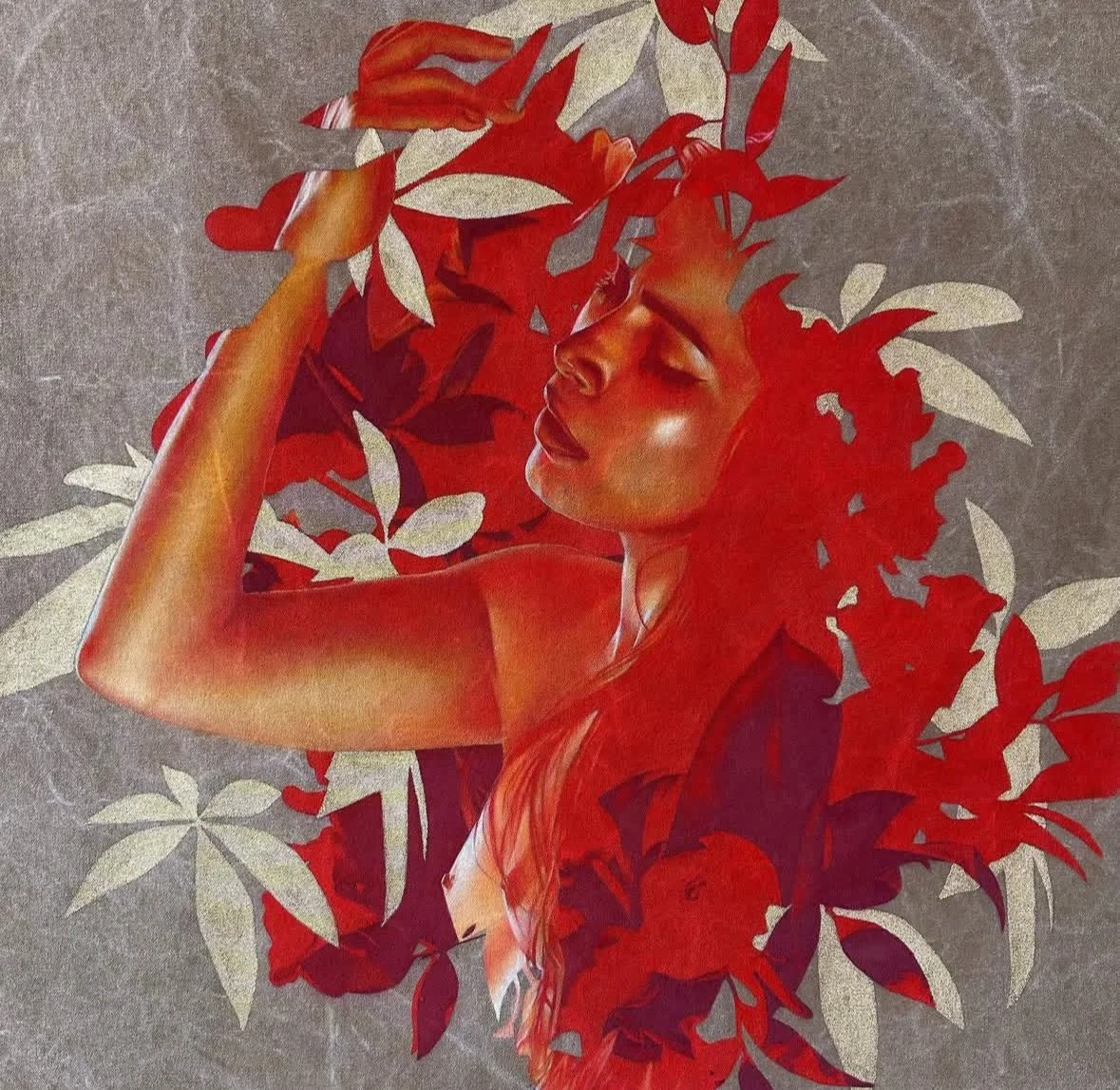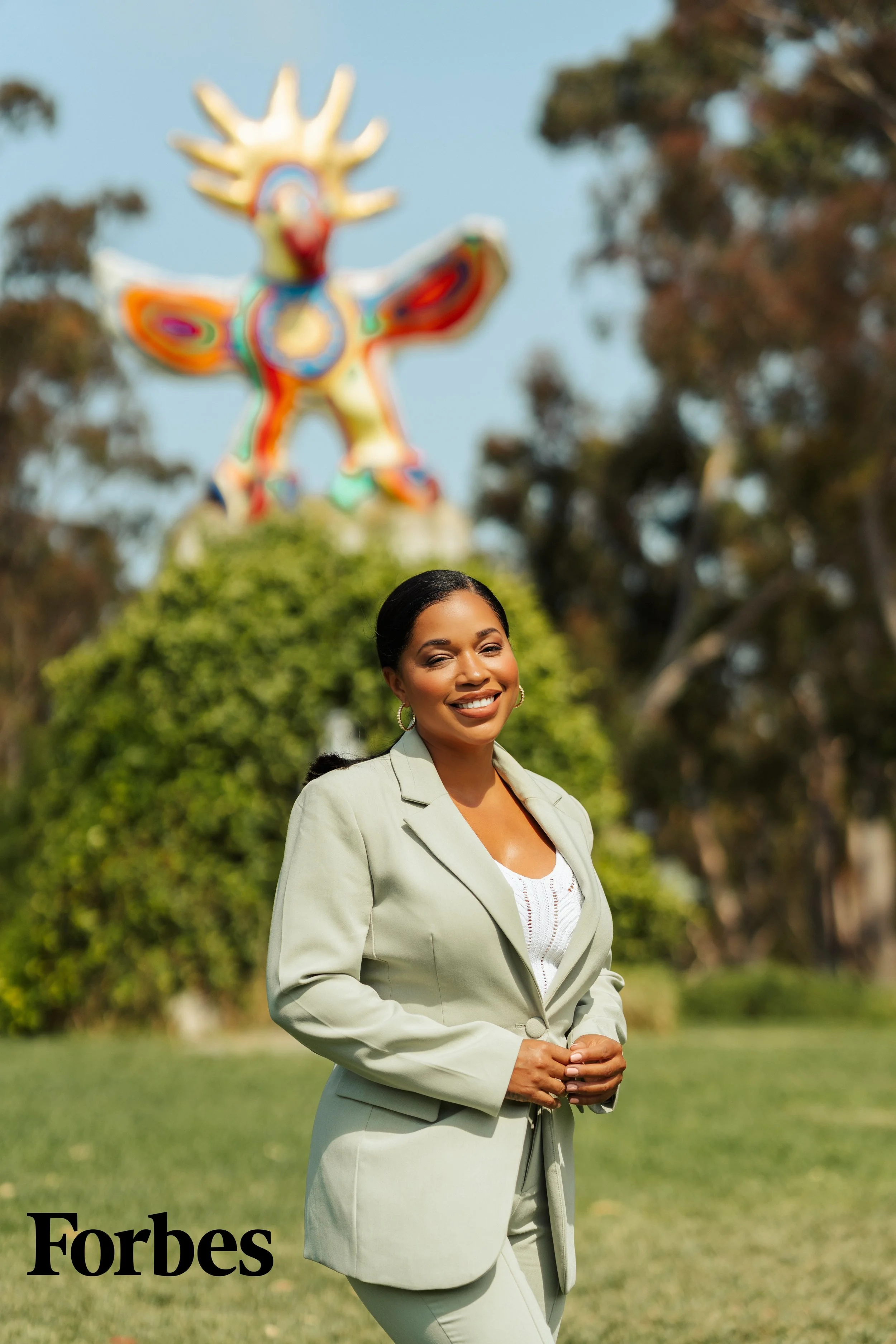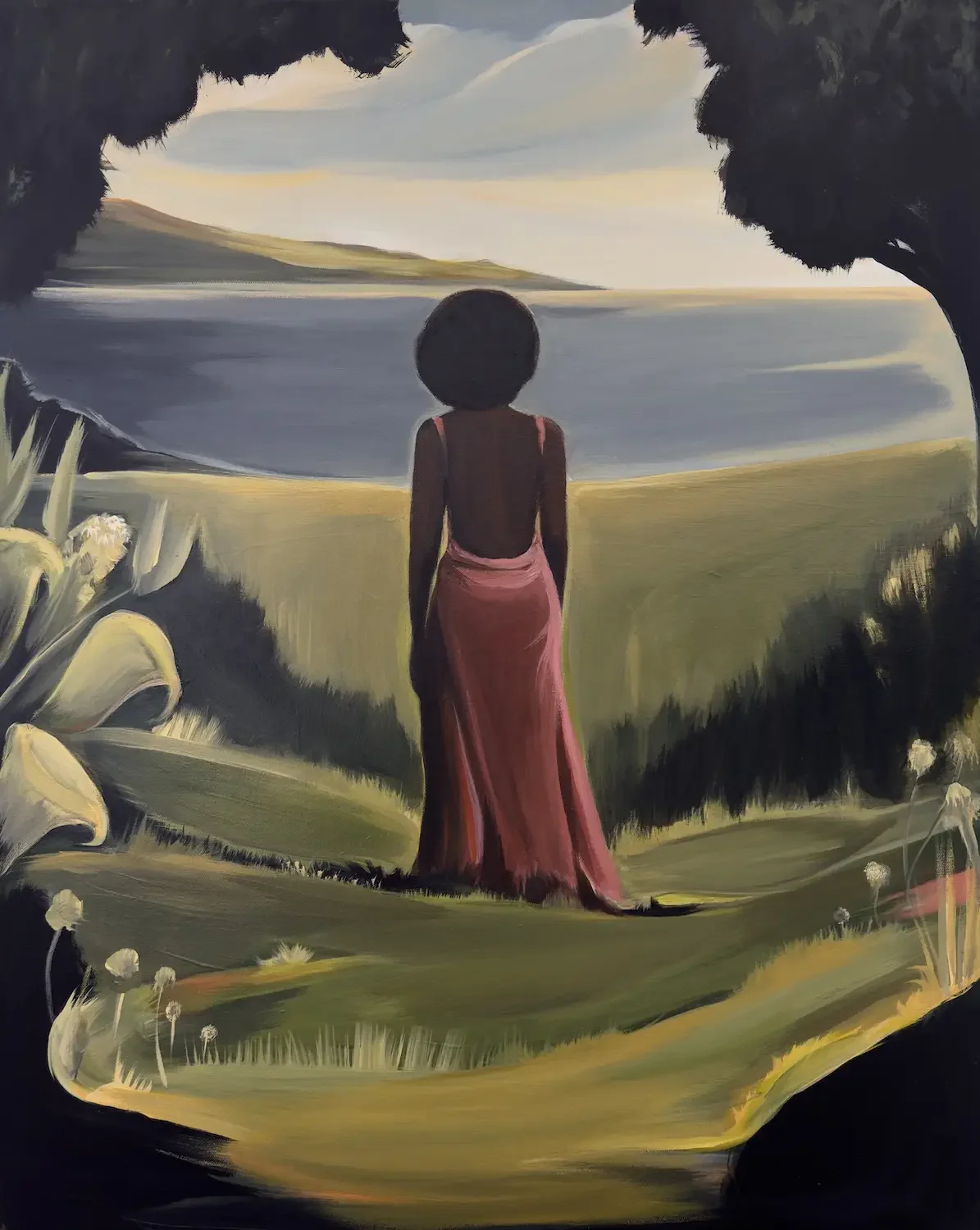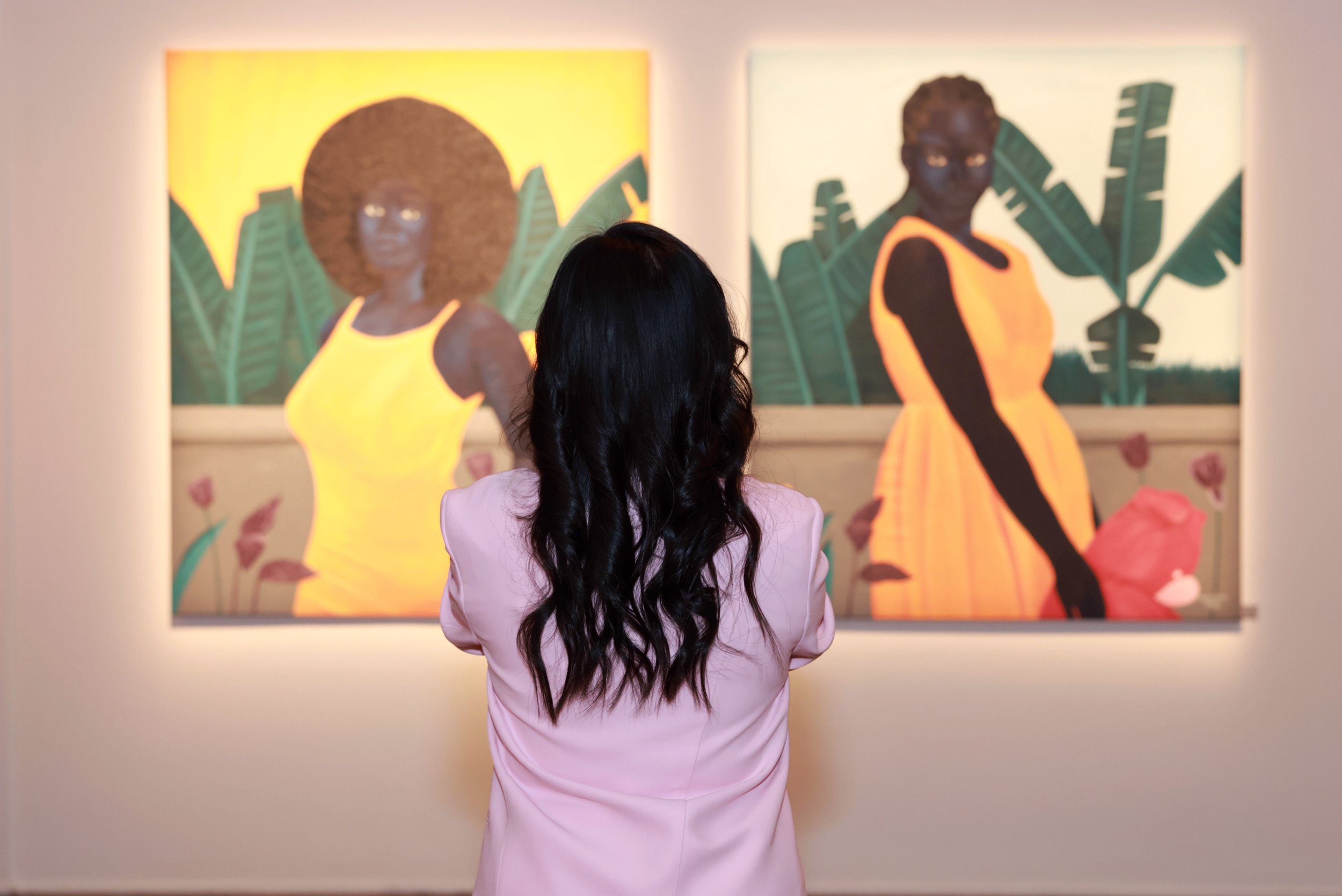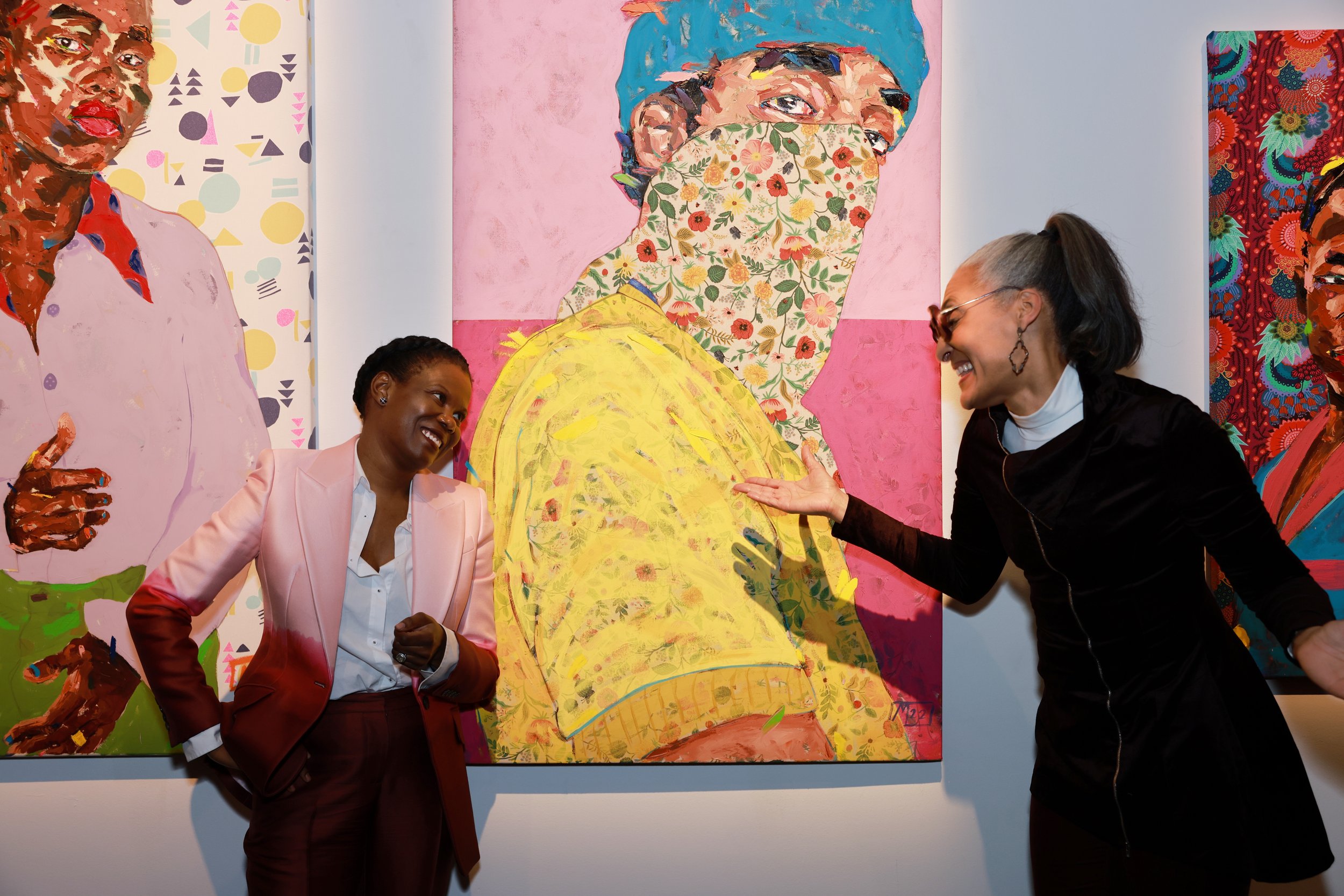Featured Artist Julia Grayson
A Good Place to Hide
November 13 – December 13, 2025 | Hotel Lafayette, San Diego
Transforming a Historic Bungalow into a Sanctuary of Art
This fall, Hotel Lafayette and international curator and Art Genesis founder Mashonda Tifrere present A Good Place to Hide, an immersive exhibition that reimagines art as a refuge for the soul. Running from November 13 through December 13, 2025, the show transforms the hotel’s historic four-bedroom bungalow into a living gallery, a sanctuary where fine art, design, and creative culture intertwine to inspire reflection, discovery, and connection.
The exhibition explores how art can restore balance in a fast-paced world. Visitors are invited to wander through intimate indoor and outdoor spaces alive with color, form, and texture, discovering beauty in stillness and creativity in quiet moments.
Curator Mashonda Tifrere shares her inspiration:
“Art has always been a refuge for the soul, a space where we can pause and breathe amid the world’s relentless rhythm. Through textured canvases, evocative black-and-white photography, and sculptural works that echo the rhythm of the environment, these 17 artists remind us that true adventure often unfolds in quiet introspection — urging viewers to wander, wonder, and reclaim their own hidden truths.”
Featuring works by Colm Dillane, Denja Harris, Dave Eassa, Elizabeth Waggett, Israel McCloud, Jerome Lagarrigue, Julia Grayson, Lacey McKinney, Megan Lewis, Monica Canilao, Nikko Muller, Reni Soares, Rugiyatou Ylva Jallow, Steven Hill, Steven Kirby, Swoon, and Yulia Bas, the exhibition bridges global and local creative voices in a deeply sensory experience.
A Good Place to Hide invites guests to slow down and experience art not only as observation, but as meditation, a return to presence, nature, and the intimate joy of creation.
For additional information and sales inquiries, please contact sales@artleadher.com.
Audio Art Journey: Inscape At The Stuart Collection
Last summer, when writer, curator, singer, and performer Mashonda Tifrere met Jess Berlanga Taylor, Director and Curator of the Stuart Collection at UC San Diego, she knew she had found her art family. The meeting sparked a creative partnership that has now blossomed into Inscape, a groundbreaking audio guide project blending Mashonda’s twin passions for art and wellness.
The Stuart Collection is one of San Diego’s hidden gems, featuring works by renowned artists such as Robert Irwin, Barbara Kruger, Niki de Saint Phalle, Do Ho Suh, Elizabeth Murray, Mark Bradford, Jenny Holzer, and John Baldessari. While the collection has long been a remarkable if under-the-radar cultural treasure, Inscape offers visitors a new reason to explore it: an immersive, contemplative experience that turns a sculpture walk into a journey of self-connection.
“This project’s experiential nature immerses visitors in the Stuart Collection by creating a personal, contemplative connection with each piece,” says Berlanga Taylor. “Mashonda’s passion for both artistic expression and mindful reflection is obvious in the curation of this experience.”
Mindfulness in Motion
Mashonda describes Inscape as a kind of mental mindfulness parkour. For each artwork, she uses her warm and steady voice to share insights about the artist, the work, and when possible the inspiration behind it. She then guides visitors through simple mindfulness practices, encouraging them to pause, reflect, and connect with the art on a deeper level.
“It was beautiful for me to create this new lens of wellness and intentionality for the art viewer,” Mashonda says. “To look at art as this portal to wellness and transformation.”
San Diego as a Creative Haven
For Mashonda, Inscape is as much about place as it is about process.
“San Diego is my safe haven,” she says. “I couldn’t have done this project anywhere else because San Diego provides so much peace and so much nature. And that’s exactly what I needed to be enveloped in to create the Inscape Project.”
With Inscape, visitors to the Stuart Collection can expect more than a tour, they’ll embark on a meditative journey, guided by one of today’s most versatile creative voices, discovering not only the art before them, but also a deeper connection within themselves.
Read more HERE
Somewhere In Between
Curated by Mashonda Tifrere
July 26 – August 16, 2025
Quint Gallery, La Jolla, CA
Victor Ubah - Serenity Shore, 2024
Art Genesis is proud to announce Somewhere In Between, a summer group exhibition curated by Mashonda Tifrere of Art Genesis, in collaboration with Quint Gallery. The exhibition will be on view from July 26 – August 16, 2025, with an Opening Reception on Saturday, July 26, from 6:00–8:00 PM at Quint Gallery in La Jolla, CA.
Conceived by Tifrere as an exploration of dimensionality, Somewhere In Between weaves together narrative and abstract paintings alongside ceramic sculptures—each serving as an expressive portal into intangible realms and metaphysical landscapes.
Featured Artists
Victor Ubah (Lagos, Nigeria) | Taylor Chapin (San Diego, CA) | Megan Gabrielle (New York City & Sacramento, CA) | Sasha Koozel Reibstein (San Diego, CA) | Nathan Wong (Sonoma, CA) | Elizabeth Waggett (Manchester, UK / Texas)
About Quint Gallery
Founded in 1981 by Mark Quint, Quint Gallery has been a cornerstone of San Diego’s contemporary art scene for over four decades. Across nearly twenty locations and countless exhibitions, the gallery has championed both internationally acclaimed artists and those of the Southern California–Baja region, operating on an artist-first model that values risk-taking and adventurous work.
You can read more about Mashonda’s work and vision for Somewhere In Between in these recent features:
Mashonda Tifrere’s “Somewhere In Between” Opens in San Diego – San Diego Magazine
Exhibition Details
Quint Gallery – 7722 & 7655 Girard Avenue, La Jolla, CA 92037
July 26 – August 16, 2025
Open by Appointment
Taylor Chapin’s Fever Dreams (2025)
Megan Gabrielle’s Cala Violina (2025)
ArtLeadHer Presents: Roots and Realms
Gift From The Otherworld
ArtLeadHer proudly presents Roots and Realms, a stunning exhibition showcasing the works of Rugiyatou Ylva Jallow. This powerful collection delves into themes of identity, heritage, and cultural connection, offering a deeply personal yet universal exploration of self-discovery.
ABOUT THE ARTIST
Rugiyatou Ylva Jallow (b.1990 in Stockholm, Sweden), currently residing in Los Angeles, is a Swedish-Gambian visual artist known primarily for her work with acrylic, oil paint, and her use of threads. Her bold self-portraits ensnare emotivity as each layer resonates with the artist's internal and outward struggle of feeling distanced from the world around her, as she reconciles the dichotomies of bridging multiple cultures as a mixed woman.
Thresholds of The Unknown
Raised by her Gambian father and stepmother, Rugiyatou was immersed in West African values and culture throughout her life in Sweden. She credits her Swedish mother and grandmother as early artistic influences, inspiring her to begin painting from a young age. Her upbringing has deeply influenced her work, leading her to portray black subjectivity and explore her mixed Swedish-Gambian identity and the complexities surrounding belonging.
Jallow’s use of color to depict black, white, and mixed skin tones, along with her distinctive application of threads, serves as a visual representation of equality and connection across races. The floating hands symbolize ancestral presence, offering protection and embrace. Bright colors further emphasize the artist’s profound connection to nature and her sense of belonging on Earth.
Sacred Shields
Check out Roots and Realms opening night during Frieze LA and experience this moving exhibition firsthand. Currently on view at NeueHouse Venice until May 17th.
Please RSVP at info@artleader.com



Navigating Colorism: The Impact of Amy Sherald's Grayscale Portraits
Amy Sherald is an artist renowned for her unique approach to portraiture, particularly in how she navigates the complexities of race and identity through her work. Her exhibition has sparked conversations that often reveal the underlying tensions associated with the "white gaze." The term refers to the societal tendency to view the world through a white lens, influencing how people of color are perceived and represented. This essay will explore Sherald's artistic technique and the implications of her work in the context of the white gaze, drawing on a personal experience that underscores these themes.
To Tell Her Story You Must Walk in Her Shoes (2022).
While attending the Amy Sherald exhibition at the San Francisco Museum of Modern Art, I experienced a thought-provoking interaction with an older white woman that highlighted the complex themes of colorism and representation within the realm of art. Without introducing herself or exchanging pleasantries, she approached me, her expression filled with judgment and confusion. The first words she spoke, while examining the hue of my bare hand, were, “May I ask you something? You are a woman of color to some extent. What is your opinion on her portrayal of skin tones?” Initially taken aback by her phrasing, I needed a moment to collect myself and respond thoughtfully. “Are you referring to the grayscale?” I inquired. “Yes,” she replied, her tone somewhat frantic. “I believe that black individuals should be depicted in black; the gray is unappealing.” She continued to voice her dissatisfaction with Sherald's representation of skin tones. Her comments were striking, revealing a limited perspective on racial identity and the nuances of colorism. Not only was she critical of Amy’s artistry, but she also made assumptions about my skin tone and its relation to my identity as a black person, suggesting that my lighter complexion somehow made me black “to some extent.” This interaction could have easily escalated had I not chosen to respond with a sense of higher awareness. Acknowledging that the woman was at least seventy-five years old, I was determined not to let this encounter mar the enjoyable day I had planned at the museum. Despite my initial shock, I opted to engage her, understanding that art often provokes challenging yet essential discussions. I kept my response concise: “Amy uses gray for skin tones to encourage viewers to focus on the humanity of her subjects.” I also gestured toward a nearby video room where a short documentary about Amy was being screened, providing further context about her work. In response, the woman rolled her eyes and bluntly stated, “Well, the people are black, and the gray looks awful.” The interaction prompted me to reflect on the persistent feeling of exclusion that many of us experience in such spaces. I questioned whether her reaction would have been as intense if Amy Sherald were a white artist creating portraits of gray individuals. This contemplation deepened my appreciation for my work within the art community and reinforced my commitment to advocating for Black and Brown artists. Ultimately, it seemed that this woman was less than pleased with the presence of a Black female artist occupying the entire fourth floor of the museum, showcasing fifty portraits of Black individuals.
The concept of the white gaze is crucial in understanding this interaction. It denotes how the default perspective in society is often that of white individuals, leading people of color to navigate their identities and expressions with an awareness of how they will be received by a predominantly white audience. This power dynamic establishes whiteness as the norm, rendering other racial identities as secondary or in need of justification. In this context, Sherald's work becomes a powerful commentary on these dynamics, challenging the viewer to confront their own perceptions and biases.
A Mid-summer Afternoon Dream, 2021
As Soft As She Is, 2022
Sherald's decision to paint her subjects in grayscale is a deliberate choice that complicates the traditional understanding of race and color. In her interviews, she articulates a desire to present her characters as multifaceted individuals, transcending the limitations often imposed by color. By employing grayscale, she removes the immediate associations tied to skin tone and invites viewers to engage with the humanity of her subjects rather than reducing them to mere representations of race. This technique serves as a form of resistance against the color-as-race paradigm, allowing Black figures to occupy space within the historically white portraiture tradition.
In this way, Sherald's art not only challenges the viewer's perceptions but also reclaims agency for her subjects. By focusing on the inner lives and emotions of her characters, she elevates their existence beyond societal stereotypes and expectations. This approach fosters a deeper connection between the viewer and the artwork, encouraging empathy and understanding.
Photo by Olivia Lifungula, Courtesy Hauser & Wirth
The encounter with the older woman at the museum prompted me to once again reflect on the state of humanity as we approach 2025. While I have many white friends and colleagues who are actively engaged in forward-thinking discussions, there remains an urgent need for open dialogue about race, representation, and the intricacies of colorism. Sherald's work is a crucial contribution to this discourse, emphasizing the necessity of acknowledging and dismantling the preconceived notions that arise from viewing art through outdated frameworks.
During a recent conversation between Amy and one of my favorite authors, Ta-Nehisi Coates, Amy articulated her mission-
“It is about letting go of looking at people looking at me.”
For me, this signifies that as a Black person in these spaces, the emphasis should be on our inner experiences and perspectives rather than external judgments. Focusing on our interiority allows for a deeper exploration of identity and authenticity, fostering a richer understanding of ourselves and our narratives within the art world and beyond.
Amy Sherald: American Sublime
San Francisco Museum of Modern Art
November 16, 2024–March 9, 2025
Whitney Museum New York
April 9 2025- August 2025
The Smithsonian’s National Portrait Gallery
September 19, 2025 - February 22, 2026

ArtLeadher Presents:
“Uninterrupted Resilience”– Celebrating 10 Women Artists at the Diane von Furstenberg Flagship Store.
Opening October 9th - November 8th
“Resilience begins with a purpose that transcends the self; this serves as the foundation upon which women construct their lives. Our capacity to discern and recover is enriched by the insights gained through experience and fueled by our passions.” - Mashonda Tifrere
Rugiyatou Ylva Jallow
The exhibition will feature the remarkable works of ten visual artists: Lindsay Adams, Alanis Forde, Martine Johanna, Sophie Kahn, Annette Hur, Kandy G. Lopez, Rugiyatou Yiva Jallow, Bre Andy, Anoushka Mirchandani, and Natia Lemay. Their varied creations encompass sculpture and fiber art, showcasing a dynamic selection of contemporary abstract, portrait, and figurative paintings from both emerging and early-career artists.
Through this meaningful collaboration, ArtLeadHER seeks to celebrate the talent, strength, and breadth of women’s artistic contributions. We invite you to immerse yourself in and connect with these powerful artistic expressions.
The Diane von Furstenberg flagship gallery is renowned for its dedication to artistic and cultural endeavors. A fashion designer and philanthropist, Diane von Furstenberg is recognized for her impact on fashion and her unwavering commitment to women's empowerment and creativity.
“The older I get, the more impressed I am with women. I have yet to meet a woman who is not strong. They don’t exist.” - Diane von Furstenberg
Lindsay Adams
ECHOES OF TOMORROW: WE ARE THE FUTURE ANCESTORS
CURATED BY: MASHONDA TIFRERE
Artist Shakka Smith (photo on the left) Artist Jamel Shabazz (photo on the right)
Echoes of Tomorrow: We Are The Future Ancestors is an exhibition running from June 12th- June 26th at the Oculus World Trade Center.
Gallery Details | Wednesday- Sunday 12pm-7pm
Featuring: Jamel Shabazz, Flo Ngala, Johnny Nunez, Laylah Amatullah Barrayn, Steven John Irby, Shakka, Shareif Ziyadat
Mashonda Tifrere is pleased to present Echoes of Tomorrow: We Are The Future Ancestors! This exhibition is a photographic experience in celebration of Black Music Month and Juneteenth. The presentation is a documentation of New York life and culture woven through five decades of music, politics and everyday happenings.
Each photograph is a love letter that encapsulates the essence of our culture while preserving our history as we shape legacies for future generations.
This exhibition is in partnership with The NYC Culture Club, a 501(c)(3) nonprofit organization that offers opportunities for curators and artists to host exhibitions, free of charge and commission. All shows are open to the general public. NYC Culture Club has welcomed over 120,000 visitors since opening at the World Trade Center in June of 2021.






A Time Was Had: Is An Awakening Discussion with Joy Simmons
Joy Simmons and Mashonda Tifrere engaged in an intimate dialogue as part of Art Genesis' “A Time Was Had: Is An Awakening,” delving into Simmons' illustrious career as an art collector.
Embarking on her art collection journey in 1974 with a print by Elizabeth Catlett, Simmons has transformed her home into a haven adorned with works from prominent art luminaries like Mickalene Thomas, David Hammons, Kerry James Marshall, Julie Mehretu, and Hank Willis Thomas. Her aspiration is to cultivate a collection that resonates with the essence of our time, championing Black art and culture.
Simmons eloquently expresses the profound impact of her collection, stating, “After confronting dragons throughout the day, grappling with both macro and micro aggressions as a Black woman, returning home to a curated space that nourishes and uplifts your spirit is a sanctuary. Every day, walking into my home feels like a rejuvenating experience.”
Pérez Art Museum Miami
Honoring Curator and Activist Mashonda Tifrere at the 11th Annual Art + Soul Celebration
On February 10, 2024, Pérez Art Museum Miami (PAMM) hosted its 11th annual Art + Soul Celebration, a prominent social and fundraising event in Miami dedicated to supporting and celebrating the PAMM Fund for Black Art. This year's festivities paid tribute to curator and activist Mashonda Tifrere. The event was orchestrated by co-chairs PAMM Trustee Eric Johnson and Holly Gaines, along with Tracey Robertson Carter and Christopher Carter, Patricia Howell, and honorary co-chair Deryl McKissack.
PAMM Director Franklin Sirmans expressed enthusiasm about the occasion, stating, "PAMM’s Fund for Black Art and the annual Art + Soul Celebration are always embraced as opportunities to champion our mission of supporting artists and reflecting the vibrant diversity of our community." Sirmans highlighted the honor bestowed upon Mashonda Tifrere, recognizing her longstanding commitment to creating equitable, accessible, and expansive spaces for artists through her organization, ArtLeadHER, which has been providing opportunities for women in the visual arts since 2016. Despite being renowned as a singer and songwriter, Tifrere has been a visual art collector since the age of 18, and her love for art and advocacy for artists permeate her work and impact numerous artists. Tifrere previously participated as a panelist in a 2022 museum discussion on Collecting Contemporary Caribbean Art.
In 2023, PAMM successfully raised $1.6 million for the fund. The fund, initially named the PAMM Fund for African American Art, underwent a renaming in 2022 to the PAMM Fund for Black Art to more inclusively encompass the various identities represented, including those from Latin America and the Caribbean, in addition to the African Diaspora. Notable acquisitions for the museum in 2023 included "With a Heart of Gold," an installation crafted from recycled women's shoes by Willie Cole, and "The Blues," a multi-paneled photographic work by Carrie Mae Weems. Past Art + Soul honorees feature Jesse Williams, Dr. Lowery S. Sims, Pamela Joyner, and David Alan Grier.

WHAT IS ART LEADHER?
After many years of collecting art and connecting with the artists themselves, Mashonda Tifrere saw an opportunity to support emerging and existing artists in spaces where they are underrepresented.
[Notes from the Top of the South | Artist, Lindsay Adams]
Why Art LEADHER?
-
Awareness
Women and people of color are continually underrepresented in the art world. We are here to amplify their work.
-
Connection
We listen to the stories and visions of each artist to ensure that are suited to represent their best interests as artists and entrepreneurs.
-
Protection
We vet all of our buyers to ensure that the integrity of each piece is upheld by whoever collects them. That means less chances of auctions!
AS SEEN IN


